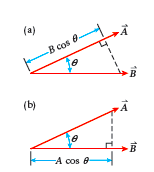Chapter 1. The Dot Product
9.1 – Introduction - The dot product
The dot product is used when multiplying two vectors together to give a scalar quantity.
For two vectors →A and →B separated by angle θ, as shown in the diagram, their dot product C is defined as

by an angle, θ
C = →A • →B = ABcosθ
which you can read as, “C equals A dot B.”
A and B in this equation are the magnitudes of vectors →A and →B respectively. Since the dot product of two vectors is a scalar quantity, →A • →B is also called the “scalar product” of →A and →B.
Physically, the dot product →A • →B is a measure of how parallel the two vectors are.
We can think of it as the magnitude of vector →A multiplied by the component of vector →B that is parallel to →A.

Looking at diagram (a) notice that B cos θ is the component of →B that is parallel to →A. That is, B cos θ tells us how much of →Bpoints in the direction of →A.
Alternatively, looking at diagram (b), the dot product →A • →B can be thought of as the magnitude of vector →Bmultiplied by the component of vector →A parallel to →B.
9.2 - More about the dot product
1. The dot product is commutative
This means that the order of the vectors in the dot product does not affect the result.
→A • →B = →B • →A
2. The dot product is distributive
This means brackets can be expanded like this
→A • (→B+→C) = →A • →B + →A • →C
Worked Example 1.
The physical quantity work, W, is calculated as the dot product of applied force on an object, →F and the displacement of the object, →r during the application of the force,
W = →F • →r
A sled is transported 100m across some ice by pulling on a rope that takes an angle of 30° with respect to the direction of travel (horizontally across the ice). To move the sled a constant force of 50N is applied along the rope.
We want to calculate the work done on the sled during its displacement so we calculate the dot product of the force and displacement vectors.
W = →F • →r = F r Cos 30 = 50(100) Cos 30 = 4330 J
Notice that this means that the quantity work is equal to the applied force multiplied by distance travelled in the direction of the force. The dot product takes the component of the force vector →F in the direction of the displacement vector →r.
9.3 - Special cases for the dot product
1.The dot product of parallel vectors is equal to the product of their magnitudes.
If →A and →B point in the same direction, →A • →B =AB Cos 0 = AB
2. The dot product of perpendicular vectors is equal to zero.
If →A is 90° to →B, →A • →B = AB Cos 90 = 0 (since Cos 90 = 0)
3. The dot product of vectors pointing in opposite directions is equal to the negative product of their magnitudes.
IF →A points 180° to →B, →A • →B = AB Cos 180 = -AB
Try it yourself 1
Calculate the dot product for the following pairs of displacement vectors
Question Sequence
Question 1.
→A = 2m in the x direction, →B = 6m in the y direction
9.4 - Calculating dot products in component form
It is useful to be able to calculate the dot product of two vectors if they are given in component form, →Ax, →Ay, →Az and →Bx, →By, →Bz for example.
Now we can say
→A • →B = AxBx + AyBy + AzBz
We can see this must be true by separating A or B into the sum of three vectors (→Ax, →Ay, →Az and →Bx, →By, →Bz)
Then
→A • →B = (→Ax + →Ay + →Az) • →B = →Ax • →B + →Ay• →B +→Az• →B
From our definition of the dot product, A.B is equal to A multiplied by the component of B in the direction of A, so it follows that
→Ax • →B + →Ay• →B +→Az• →B = Ax.Bx + Ay.By + Az.Bz
Worked Example 2
Try it yourself 2
Find the dot product, →A • →B of the following pairs of vectors in component form.
Question Sequence
Question 5.
→Ax = 2, →Ay = 4, →Az = 3, →Bx = 6, →By = 2, →Bz = 1